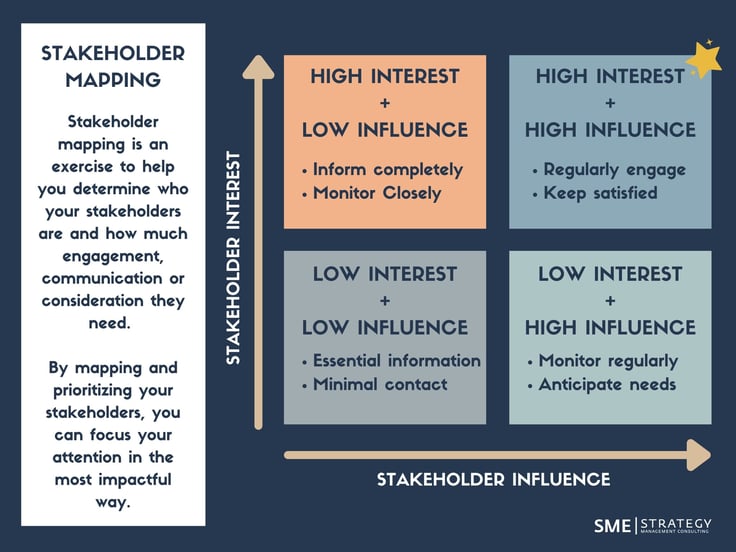What is Stakeholder Engagement, and Why is it Important for Strategic Planning?

Engaging stakeholders is crucial for successful strategic planning. It involves identifying, understanding and involving people who have a stake in the outcome of the plan. Effective stakeholder engagement management requires a comprehensive approach that includes ongoing communication, listening, and collaboration. This article discusses the importance of stakeholder engagement in strategic planning and offers tips on how to effectively engage your stakeholders in the process.
What is Stakeholder Engagement & Why is it Important?
Stakeholder engagement is a process that organizations can follow in order to listen to, collaborate with, or inform (or a combination of all three) their existing stakeholders. This process entails identifying, mapping and prioritizing stakeholders to determine the best tactics for effective communication while making the best use of available resources.
Stakeholder engagement helps organizations to proactively consider the needs and desires of anyone who has a stake in their organization, which can foster connections, trust, confidence, and buy-in for your organization’s key initiatives. When done well, stakeholder engagement can mitigate potential risks and conflicts with stakeholder groups, including uncertainty, dissatisfaction, misalignment, disengagement, and resistance to change.
When it comes to strategic planning, stakeholder engagement is critical. It’s important that your stakeholders understand why you exist, where you want to go, and how you’re going to get there. Furthermore, it’s essential that your KEY stakeholders (see our stakeholder mapping section below) are aligned with and bought into the strategic direction of your organization so they can become advocates that can help you achieve your mission and vision.
Additionally, your stakeholders will have a wealth of relevant knowledge and experience that your senior leaders may want to take into consideration to help your organization be more impactful, sustainable and viable over the long-term.
What is a Stakeholder?
Stakeholders are specific groups of people (ex: not the general public), each with different desires and needs from the organization. A stakeholder is anyone who has a stake in your organization, either through interest, influence or both. Stakeholders can range from shareholders, to staff, board members, volunteers, funders, government, customers and beyond.
note:
Stakeholders and ‘publics’ are different subsets and require different communication strategies. While specific members of the public may be stakeholders, not all of them are. Publics are either unaware or aware of your organization but may lack both interest and influence at this stage. Some publics, especially aware publics, have the potential to become future stakeholders. For the purpose of this article, we are focusing solely on existing stakeholders.
Related Content:
What is the Strategic Planning Process
How to Create Team Alignment and Why it's Critical in 2023
Mapping your Stakeholders
Through first mapping your stakeholder groups, your organization can develop a plan to engage with each group in a way that works best for them. This will help your organization to make the best use of your resources by not over communicating with groups that do not require the same level of attention as your high interest and high influence group, and by making sure to engage your higher interest and influence groups in greater depth.

When mapping your stakeholders, group them into one of the four categories:
-
Low Interest & Low Influence
For stakeholders with low interest and low influence, one-way communication of essential information will likely be sufficient in most instances. -
Low Interest & High Influence
This group is more influential than the low-low grouping. Although they still have a low interest in regular communication from your organization, it’s important to monitor this group regularly, keep them informed of critical information, and anticipate any interests or needs they may have. -
High Interest & Low Influence
This group is more interested than the low-low grouping. Although they may not be as influential as other stakeholders, you may wish to have regular, robust communication and consider two-way communication with this highly interested stakeholder group. -
*High Interest & High Influence (these are your KEY stakeholders)
This group is both interested and influential and will require more resources to engage with effectively. This is your priority grouping of stakeholders who will require regular, robust, two-way communication tactics to keep this group satisfied.
When determining how you will engage with each group, it’s important to remember to be inclusive. While some stakeholder groups will have different needs than others, it is also likely that individuals within stakeholder groups may also have different needs or desires than each other. Some considerations when developing an inclusive engagement plan may include: connectivity and device access, intercultural differences in communication styles or preferences, or accommodations due to age, ability, language, and otherwise.
Note: Stakeholder mapping is not a one-time process. Stakeholder groups change and evolve alongside your organization. It’s important to review your stakeholder groups and update your stakeholder communication plans regularly - We recommend doing this annually, as a part of your strategy review process.
Stakeholder Management for Strategic Planning
Prior to your strategic plan creation or strategy review, we recommend mapping (or re-mapping) your stakeholder groups to determine your groupings. Once you’ve identified your key stakeholders, the high-influence/high-interest grouping, determine if you have enough resources to engage in regular two-way communication with ALL of them prior to strategic planning, throughout the process, and on an ongoing basis afterwards.
If you do not have the resources to engage with ALL of your high-high grouping of stakeholders, determine with your leadership team which ones are the MOST influential and the MOST interested. Pare the list down to the number of specific stakeholder groups that you can effectively engage in ongoing two-way communication.
You will still need to communicate with the rest of these stakeholders, but you may use similar tactics as you would with some of the other stakeholder groupings that are less intensive than your key stakeholders.
Once you’ve determined your key stakeholders for ongoing two-way communication (whether the entire list, or a pared down version) it’s time to determine how you will engage with them throughout the strategic planning process. You may communicate in the same way with all of these stakeholder groups, or you may determine that each group has different needs.
While there is no single way to do this 'correctly', we’ve compiled some recommendations and options for managing your stakeholder communication with your high-priority stakeholder groups while developing and implementing your strategic plan:
Surface differing perspectives among your internal stakeholders in minutes
Before you move deeper into external stakeholder engagement or strategic planning, it’s often helpful to understand how key internal stakeholders interpret priorities, risks, and direction.
The One Destination Scorecard is a short, 5-minute exercise designed to help you compare perspectives, surface differences, and create a more objective starting point for discussion.
-
BEFORE starting the strategic planning process with a strategy facilitator, consider the following:
-
Surveys - these can be used to help gather input from a wide variety of stakeholders prior to your strategy sessions for your leadership team to consider. This method may be less labor intensive than other two-way communication strategies. While this method will work for many stakeholders, others may wish for more comprehensive communication method.
-
Town Hall Sessions - these group sessions may include multiple stakeholder groups simultaneously, or may be devoted entirely to one stakeholder group, depending on their size or differing needs. These sessions can be held virtually or in person and offer an opportunity for a two-way discussion between key stakeholders and senior leaders prior to diving into the strategic planning process. This method allows you to engage multiple stakeholders simultaneously and have a structured, yet organic, conversation. While this method is time efficient, some stakeholders may wish for one-on-one interaction.
-
Interviews - these can be done one-on-one or in small groups (within one stakeholder subset and can be held virtually or in person. Interviews create an opportunity for a structured and open dialogue without the added "noise" of a group session. This method allows for a deeper conversation with key stakeholders and provides opportunities to really listen to their perspectives. While this method is highly engaging, it is time-consuming and may not be practical to undertake for all of your key stakeholders.
If you prefer to facilitate your strategic planning process on your own, we have a variety of strategic planning tools available to help you get started!
-
-
DURING the strategic planning process
-
Session Participation - While it is important to consult your key stakeholders throughout the strategic planning process, we don't recommend involving them all in your planning sessions. We recommend including only stakeholders with decision-making power in your strategy sessions. This will likely include your C-suite leaders and senior leadership team(s), and may potentially include board members or middle management, depending on the size of your organization and the scope of leadership duties.
-
Develop Communication Plan - Even though the rest of your stakeholders (in all four quadrants) will not be a part of your strategy sessions to create or revise your strategic plan, it is critical to devise a plan for how you will continually communicate with them on an ongoing basis. As recommended earlier in this article, your plan will need to include different tactics to engage different stakeholder groups, depending on their interest and influence. It will be of the utmost importance to prioritize your key stakeholders and make sure that they understand and are bought into the plan as early as possible.
-
-
AFTER the plan has been developed/renewed
-
Share your strategic plan - We recommend sharing your strategic plan with all of your stakeholders, regardless of which quadrant they are in. For those with lower interest or influence, you may choose to keep this high level by keeping your organization's vision, mission and values updated on your website. For those who are more invested in your plan's success, your key stakeholders, you will want to make sure that they have a deeper understanding and are aligned on your Vision, Mission, Values, Strategic Priorities, and Goals.
-
Town Hall Sessions - Holding another round of town hall sessions for your key stakeholders after you've revised or created your strategic plan is a great way to promote alignment and engagement. Beyond disseminating the information that is included in your plan, these sessions will allow for added clarity and context, and for stakeholders to understand more about how you will implement this plan and how they will contribute to the organization's success.
-
-
ONGOING - while the plan is being implemented
-
Implement your Communication Plan - After developing a communication plan as part of your organizational strategy, Remember, it is crucial to ensure its implementation in conjunction with your strategic plan. Set clear actions, deadlines, or intervals, and designate a responsible person (Chief Strategy Officer) if you have one, to ensure the completion of these actions. Our Strategic Planning Services emphasize our ability to assist organizations in effectively communicating and implementing their plans, encompassing the entire leadership team and extending to the frontline.
-
Proactively Follow your Stakeholder Map & Engage Your Stakeholders - This is a reminder that stakeholder engagement is continuous and ongoing. Make sure to be proactive and check in with your stakeholder map to make sure that your organization is continually meeting the needs of each of your stakeholder groups, especially your prioritized key stakeholders. Ongoing tactics may include newsletters, social media posts, website updates, quarterly town hall sessions, phone calls, site visits, among others.
Leading the stakeholder conversations yourself? Start with the right questions
Once you’ve surfaced differences in perspective, the next step is guiding a productive conversation.
The 15 Questions to Ask Your Team is a leadership-level primer designed to help you frame the right discussions, surface assumptions, and raise the quality of stakeholder engagement before decisions are made.
-

-



